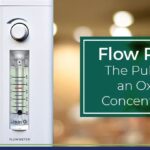Flow Rate: The Pulse of an Oxygen Concentrator

The oxygen concentrator provided by home and portable concentrators can be delivered in one of two ways: Continuous Flow or Pulse Flow. Both of these oxygen delivery methods supply medical-grade oxygen directly to the user; however, each method’s dose is calculated differently. This blog will assist you in determining which sort of oxygen supply is best for your needs.
The oxygen that flows through many of the home and portable concentrators on the market is normally measured in litres per minute, while some will offer millilitres per minute. Continuous flow oxygen concentrators typically deliver litres per minute, whereas pulse oxygen concentrators deliver millilitres per minute.
Those who require oxygen therapy will receive a prescription from their doctor specifying their oxygen flow rate requirements, such as 2.0 litres per minute (a frequent prescription). However, the specific amount you require may differ. In most circumstances, the medications will flow between 1L and 10L per minute.
There are primarily two kinds of flows available in modern-day oxygen concentrator machines:
Continuous flow oxygen
The oxygen flow from the cannula is uninterrupted and only stops when the concentrator is turned off. Regardless of the patient’s breathing patterns, these constant flow concentrators will give the same quantity of oxygen through the cannula. The flow rate can be determined at a constant volume of LPM using this form of oxygen supply (litres per minute).
Pulse dose oxygen
When the equipment detects inhalation, the concentrator automatically releases oxygen. When a patient inhales through a cannula, a “bolus,” or “pulse” dose of oxygen, is activated and released. Pulse dosage oxygen machines include “settings” that determine the amount of oxygen supplied each minute. The amount of oxygen delivered to the patient (in millilitres per minute) depends on the manufacturer, the setting, and the patient’s breathing (inhalation) rate. When the parameters are adjusted, the size of the bolus of oxygen dispensed rises.
How To Pick Among the Two?
Always examine the ‘flow rate capacity when purchasing an oxygen concentrator. The oxygen concentrator must be used according to the doctor’s prescription – the flow requirement in litres per minute (LPM) will be determined by the patient’s health and the amount of supplemental oxygen therapy required. Flow rates for some oxygen concentrators range from 250 to 750 millilitres per minute, whereas flow rates for others range from two to ten litres per minute. It’s best to choose a device with greater capacity than you’ll need — for example, if you need 3.5 LPM, get an oxygen concentrator with a 5 LPM flow rate.
It should be noted that while a setting of 2 on a pulse dosage machine is intended to approximate 2 LPM on a continuous flow system, the two are not the same. All patients considering a pulse dosage machine should talk to their doctor about the benefits and drawbacks, as well as test the unit for suitability to their personal needs.
It is preferable to choose a concentrator with the least amount of power usage. There are a variety of battery-operated variants available. The battery life varies depending on the product. Furthermore, because continuous-flow oxygen concentrators produce more oxygen, they have a shorter battery life than pulse-flow oxygen concentrators.
The “maximum oxygen output” of each portable oxygen concentrator model specifies the highest amount of oxygen that the unit can deliver (regardless of setting or breath rate). This is a useful indication of a machine’s “capacity” to produce medical-grade oxygen, similar to the horsepower of a car. Pulse dosage administration was created to enable smaller machines and longer battery life in the first place. As a result, many smaller portable devices only have pulse dose settings, whilst other bigger versions have dual-mode capabilities and can administer both continuous flow and pulses.
It all boils down to your Oxygen Requirement
Your doctor will prescribe a certain oxygen flow rate, such as 2 litres per minute if you require oxygen therapy. A 2 LPM oxygen flow rate indicates that the patient will receive 2 litres of oxygen per minute through their noses. The typical oxygen prescription ranges from 1 litre per minute to 10 litres per minute, with 70% of patients receiving 2 litres or less.
It’s crucial to talk to your doctor about your individual oxygen needs, both at rest and during exercise. Our Oxygen Specialists will be able to assist you in selecting suitable equipment when renting or purchasing your own concentrator if you determine the optimal therapeutic dose for both daytime and nocturnal use. Patients should consider their capacity to operate a pulse dose vs a continuous flow machine, as well as the suggested settings on each unit, with their doctors.
Whether you’re switching to a newer concentrator, make sure to check with your doctor to see if your oxygen needs have changed. To handle shifting needs, we strongly advise obtaining an oxygen concentrator that can give oxygen at a higher concentration than required.
Here you can get the right machine for your loved ones. Click: https://shop.servotech.in/oxygen-concentrator/




